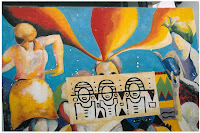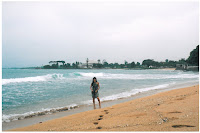Note: Although the photos were not taken with a digital camera I feel they are still worth being used to illustrate my trip to São Tomé island, which may no longer look the way it did back in January 2004 once the country has gone through quite a few political upheavals since then.
I had always wanted to visit the former Portuguese colonies and maybe find out things History books wouldn't dare mention, such as the feelings of the local residents towards us as the "invading" colonialists of the past or to which extent we had (if we had) "influenced" them.
If the Cape Verde experience had given me an insight into a reality that was not as harsh as the one endured in many of the other former Portuguese colonies I felt that the São Tomé experience might eventually share a different light taking into account the fact that during the mid 17th century the islands had become a transit point for ships engaged in the trade slave and that in 1908 São Tomé had turned into the world's largest producer of cocoa using slaves in both the coffee and cocoa plantations (roças), well beyond the Portuguese Government official abolishment of slavery in 1876.
I stayed at a colleague's (a Santomean lady working at my enterprise), whose apartment in the only non-colonial style building was located right in front of Ana Chaves Bay (named after a Portuguese Jewish noblewoman) and my stay would last an entire week.
Having left a cold winter behind I just grabbed my bikini and ventured out in search of a bit of sun, though on the way to Praia Perigosa (Dangerous Beach) I couldn't resist taking some photos at the walls of the National Bank, which were painted in vibrant colours contrasting with the 16th century Cathedral and the Portuguese fountain with the cross and the armillary sphere just a few metres away ...
If I was impressed by the "movement" of the multi coloured paintings I was equally impressed by the "golden" colour of the sand in Praia Formosa, which was next to nothing I had ever seen before, as well as the powerful "movement" of the current of its sea, certainly the reason as to why it was named "dangerous" beach ...























No comments:
Post a Comment